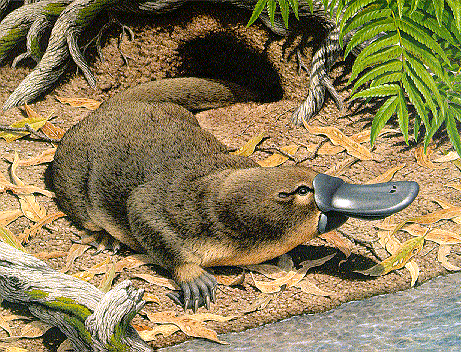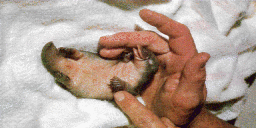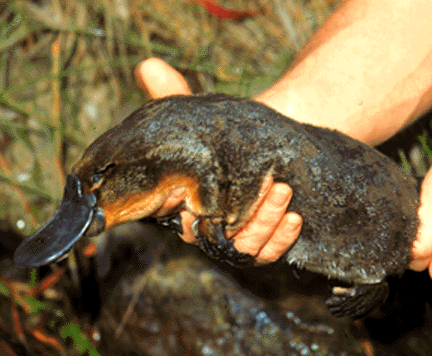
|
DUCK - BILLED PLATYPUS |

|
|
|
The
platypus
is
one
of
the
two
animals in the order Monotremata. It is the only
member of the mammal family Ornithorhynchidae.
Platypus is from the Greek platys meaning broad and pous
meaning foot, referring to the animal's webbed foot.
The platypus has several reptilian characteristics which include using the same opening for reproduction and eliminating waste products, the ability to lay eggs, cervical ribs, and local ascorbic acid synthesis in the kidney. Even though the platypus has these reptile characteristics, it is overall much more mammalian than reptilian. This unique animal has a lifespan of 10 to 15 years. The platypus is about the size of a household cat. The male platypus's body is about 50 - 60 centimeters long and the female is about 40 - 50 centimeters long. An adult male platypus weighs about 2 kilograms and a female platypus weighs about .9 kilograms. The platypus has a thick covering of waterproof hair all over its body except for the feet and bill. The outer hair is a dark brown with yellowish hair on its underside. There are about 800 hairs per square millimeter. This is denser than the fur of the river otter or polar bear. The platypus has two layers of hair. The top or longer layer is a shiny guard fur with a woolly short fur undercoat. The thermal qualities of the fur allow the platypus to withstand cold temperatures. The platypus's sensitive, pliable bill is a blue-gray, blackish color with the two nostril holes near the tip. The location of the nostrils allows the platypus to breath while the rest of the body remains under the water surface. The lower bill is smaller than the upper bill. The lower bill is held in place by two elongated dentary bones which is found in all mammals. The bill contains an electro-receptor system which has approximately 850,000 electrical and tactile receptors. When the platypus goes underwater or drives for food, it closes its ears, eyes, and nostrils. Its electro-receptor system detects the electric currents created by the muscle activity of small prey and may even help the platypus detect the electric field created when water flows over prey hidden under rocks, mud, and small debris. As the platypus gathers food in its mouth, it moves the food to its cheek pouches. When it returns to the surface, it pushes the food from its cheek pouches up to its mouth. It then grinds it with its grinding pads. The ear openings or grooves are on either side of the platypus's head. The platypus does not have external ears. These openings are closed when diving or swimming under water. Out of the water these ear openings are very sensitive to sounds. The small, beady eyes are very sensitive to movement. Cone cells have been found in the retina. This indicates the possibility of color vision for the platypus. Its eyes are well placed for scanning river banks. The platypus has four legs which extend horizontally from its body. This arrangement makes it walk on land with a shuffle like a lizard. The front feet have large webs of skin which help to propel the platypus through the water. The platypus swims with alternate strokes of the front legs. On land the webs fold back revealing the sharp claws which are used for walking and digging burrows. The back partially webbed feet have a series of sharp, curved claws which help to steer and balance the platypus when it is swimming. The claws are also used to anchor the animal while digging and to clean its fur and to help keep its fur waterproof. The paddle-like tail of the platypus is broad and flat. It is used as a rudder when swimming and to push the soil within the burrow when tunneling. Its main purpose is to store fat for when food supplies are low or when the platypus needs more energy to incubate eggs. A plump tail is a sign of good health. The body temperature of most mammals is 37 to 38 degrees Celsius. The body temperature of a platypus is about 32 degrees Celsius. This reduces the rate at which the platypus loses body heat in the water. The The platypus's red blood cells carry larger amounts of hemoglobin than any other mammal. This allows the platypus to go without air for longer periods. The heart rate of a platypus can drop from 140 - 230 beats a minute to almost 0 beats per minute. Males and females reach sexual maturity at the age of two years. Only the left ovary of the female platypus functions. The other ovary is poorly developed and does not function. This characteristic also occurs in birds. After mating the female leaves the male and lays two to three eggs in a nesting burrow. The eggs of the platypus have large yolks and rubbery shells like reptile eggs. When the babies hatch they nurse from the female's milk glands. The babies do not leave the burrow until they are about 17 weeks old. Only young platypuses have rudimentary teeth which are replaced with bony plates. The platypus is the world's only venomous furred animal. All platypuses are born with spurs on their hind feet. The spurs on the female fall off after the first year. The spurs on males become venomous during the breeding season. Platypuses are capable of making sounds. These sounds have been compared to a puppy growling. |


|
|


|
|

|
|
|
|
|
ATTRIBUTES |
|